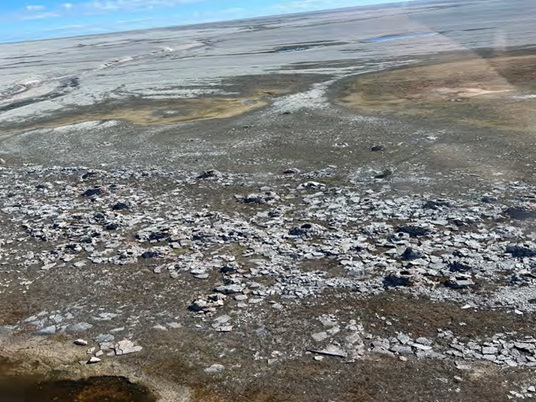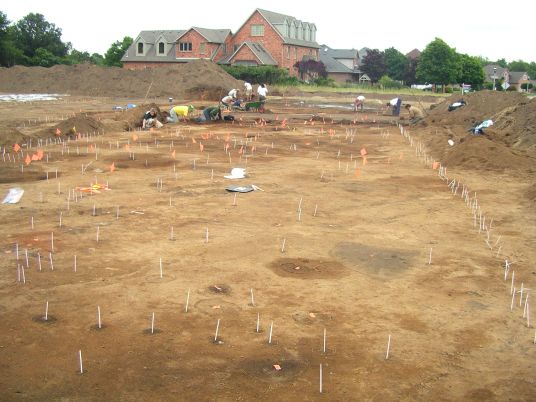Lisa Hodgetts
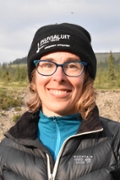
Professor -Archaeology & Bioarchaeology
PhD 2000 (University of Durham, England)
Office: Social Science Centre 3427
Tel: 519 661-2111 ext. 80105
E-mail: lisa.hodgetts@uwo.ca
Research Interests

Alexis Lucas (L) and Agnes Amos (C) "visit" archaeological sites using Google cardboard while Ry Ry Lucas looks on - Inualthuyuk School Sachs Harbour.
I am an anthropological archaeologist with a strong commitment to community archaeology. I work primarily in the north, particularly in the western Canadian Arctic with Inuvialuit research partners. I currently co-direct, with Natasha Lyons, Phase 2 of the Inuvialuit Living History Project, a digital heritage partnership between the Inuvialuit Cultural Centre, the Inuvialuit Communications Society, Parks Canada, Prince of Wales Northern Heritage Centre, Simon Fraser University and the University of Western Ontario.
I am also a zooarchaeologist, and dabble in landscape archaeology, the application of geophysical techniques in archaeology, and gender archaeology. These interests have led to fruitful collaborations with colleagues and graduate students working in Ontario, Quebec, Peru and Australia.
Another aspect of my current work deals with the ethics and practice of archaeology in Canada. It asks how past and present power structures and intersections of an individual’s gender identity, sexuality, ethnicity and age shape their experiences during training and fieldwork, and in their work places. How, in turn, do those experiences impact people’s career trajectories and approaches to collegial relationships, formal and informal teaching and learning relationships, and supervisory roles? From 2018 to 2023, I chaired the Canadian Archaeological Association’s Working Group on Equity and Diversity in Canadian Archaeology, which is addressing these questions. See the Recent Research section for more information about our work.
Recent Research
Inuvialuit Living History Project (Phase 3)
2023-2028 SSHRC Insight Grant “The Inuvialuit Living History Project Phase 3: A Relational Approach to Inuvialuit Digital Heritage” $339,799
Co-PI: Natasha Lyons
Collaborators: Ethel-Jean Gruben, Rebecca Goodwin, Alexandrea Gorton, Kate Hennessy, Tamara Voudrach
Institutional Partners: Inuvialuit Cultural Centre, Inuvialuit Communications Society, Parks Canada, Simon Fraser University, University of Western Ontario
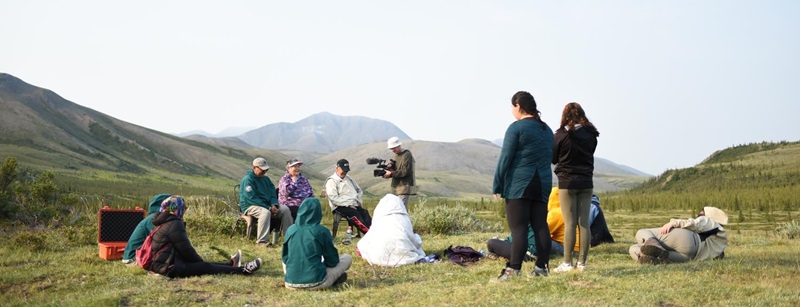
ILH Culture Camp, Imnairvik, Ivvavik National Park, 2019
The Inuvialuit Living History project, Inuvialuit Pitqusiit Inuuniarutait, brings together Inuvialuit Elders, knowledge holders, and youth with archaeologists, anthropologists, digital media specialists and museum professionals. We are exploring the most effective, culturally appropriate ways to document and disseminate multiple forms of knowledge about Inuvialuit history and heritage in the digital realm. Phase 3 involves finalizing the Beta version of the new website (see Phase 2 below) and conducting a series of engagement sessions in Inuvialuit communities to gather and incorporate feedback on the website and develop additional content before its launch. This phase also involves developing educational materials for the website that incorporate Inuvialuit pedagogies and align with NWT school curriculum. We will also create a digital preservation plan for the website and best practices for Inuvialuit digital data sovereignty in the heritage realm.
Recently Completed Projects
Inuvialuit Living History Project (Phase 2)
2017-2022 SSHRC Insight Grant “Co-creating Inuvialuit Digital Archaeology and Heritage” $312,329
Co-PI: Natasha Lyons
Collaborators: Beverly Amos, Sarah Carr-Locke, Charles Arnold, Ethel-Jean Gruben, Mervin Joe, Ashley Piskor, David Stuart, Sharon Thomson
Institutional Partners: Inuvialuit Cultural Centre, Inuvialuit Communications Society, Parks Canada, Prince of Wales Northern Heritage Centre, Simon Fraser University, University of Western Ontario
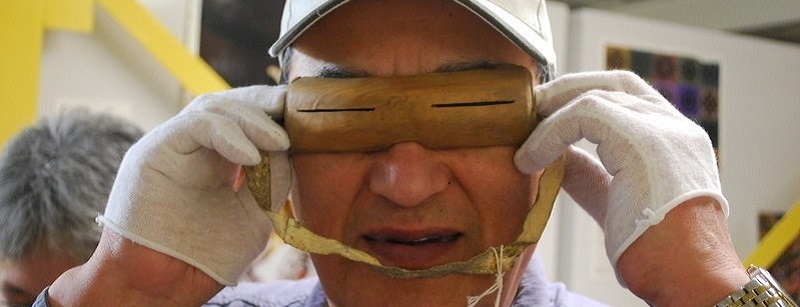
Albert Elias tries on wooden snow goggles, Smithsonian Museum Support Centre. Photo by Kate Hennessy.
From 2017-2022, we worked to build a new Inuvialuit Living History website (inspired by our work on the original website) to encompass the entire temporal and geographic span of human history within the Inuvialuit Settlement Region. Through a series of community events, created opportunities for intergenerational knowledge transfer, for sharing, documenting and applying traditional Inuvialuit knowledge in contemporary settings, and for using and encouraging the language (check out our Facebook page for details). We documented these events through photos, video and audio to create new content for the website. Each event aimed to create the conditions for traditional Inuvialuit approaches to teaching and learning, which we want to mirror through the website itself. Throughout the website, we strove to reflect and represent traditional Inuvialuit ways of knowing and being.
Towards Equity and Diversity in Canadian Archaeology: An Experiential Profile of Canadian Archaeologists in the #MeToo Era
2018-2020 Faculty Research Development Fund (Research Grants), Faculty of Social Science, The University of Western Ontario $9,562
Collaborators: Natasha Lyons, Kisha Supernant, and John Welch
This research is part of the work of the Canadian Archaeology Association’s Working Group on Equity and Diversity in Canadian Archaeology (EDCA), of which all the project collaborators are members.
The Working Group is guided by an Advisory Board comprised of: Gary Coupland, Josh Dent, Alicia Hawkins, Patricia Markert, Elsa Perry, Farid Rahemtulla, Meghan Walley and Alison Wylie
As a social science focused on understanding ancient humanity in all its diversity, archaeology is best served by a diverse community of practitioners fostered through an equitable approach to professional development and practice. In order to promote such an approach in Canada, increase diversity within our community, and fully understand the gains already made on both fronts, we are conducting a demographic survey of Canadian archaeologists. We are also interviewing archaeological practitioners representing a diverse and intersectional set of demographics to understand the dynamics that underlie their career trajectories; approaches to collegial and mentoring relationships; and their experiences of all aspects of archaeological training and work. Our overall goal is to advance conversations about how the Canadian archaeological community can: 1) support awareness and open and transparent communication around equity and diversity issues, 2) better align our practice with established and emerging ethics and shifting demographic realities, and 3) contribute to conversations about national level codes of conduct, principles of community, and sexual harassment policies in our discipline to create safer spaces for work, study, and research, and respect and celebrate diversity within our archaeological community.
Ikaahuk Archaeology Project
2012-2017 SSHRC Insight Grant “Archaeological investigation of past hunting landscapes on Banks Island, NWT” $278,200
Collaborators: Edward Eastaugh, Fred Longstaffe, Dongya Yang

Lena Wolki and Jean Harry at Head Hill archaeological site - Banks Island.
The Ikaahuk Archaeology Project (IAP) brought together Inuvialuit and archaeological approaches to understand and share the history of Banks Island, known as Ikaahuk or Ikaariaq in Inuvialuktun. Our goal was to do archaeology that matters to and includes Inuvialuit. Initially, the project focused on questions about past land use on the Island, while looking to the community for direction. Community members in Sachs Harbour then shaped the research path. They shifted the focus away from excavation because traditional Inuvialuit teachings caution against disturbing archaeological sites. The project ultimately focused on applying community knowledge and making it easier for community members to find out about Banks Island archaeological sites and artifacts investigated by the IAP and other archaeologists. See our project website and Facebook page for more information.
Selected Publications
You can access many of my publications on my Academia page.
Gruben, E.J., A. Piskor, M. Joe, L. Kotokak, E. Edgerton, N. Lyons, L. Hodgetts, K. Hennessy, D. Stewart, C. Arnold, C. von Szombathy and J. Lukuku
2022 ‘You help us tell our story’: Making Inuvialuit Living Histories in Digital and Real-Time. Études/Inuit/Studies 46(2): 91-109.
Hodgetts, L., K. Supernant, N. Lyons and J.R. Welch
2020 Broadening #MeToo: Tracking Dynamics in Canadian Archaeology through a Survey on Equity and Diversity. Canadian Journal of Archaeology 44: 20-47.
Kelvin, L. and L. Hodgetts
2020 Unsettling Archaeology [Introduction to the Special Issue]. Canadian Journal of Archaeology 44: 1-19.
Hodgetts, L.M. and Laura Kelvin
2020 At the Heart of the Ikaahuk Archaeology Project. In Archaeology of the Heart and Emotion, edited by Kisha Supernant, Jane Toswell, Sonya Atalay and Natasha Lyons. Springer Press.
Hodgetts, L. and E. Eastaugh
2017 The Role of Magnetometry in Managing Arctic Archaeological Sites in the Face of Climate Change. Advances in Archaeological Practice 5(2):110-124. [Selected as one of 10 articles featured in the journal’s Editorial Highlights of 2017]
Glencross, B., G. Warrick, E. Eastaugh, A. Hawkins, L. Hodgetts, L. Lesage
2017 Minimally Invasive Research Strategies in Huron-Wendat Archaeology: Working Towards and Indigenous and Sustainable Archaeology. Advances in Archaeological Practice 5(2):147-158.
Morris, Z., C. White, L. Hodgetts and F. Longstaffe
2016 Maize Provisioning of Ontario Late Woodland Turkeys: Isotopic Evidence of Seasonal, Cultural, Spatial and Temporal Variation. Journal of Archaeological Science: Reports 10:596-606.
Hodgetts, L.M., J.-F. Millaire, E. Eastaugh and C. Chapdelaine
2016 The Untapped Potential of Magnetic Survey in the Identification of Precontact Sites in Wooded Areas. Advances in Archaeological Practice 4(1):41-54.
Haukaas, C. and L. Hodgetts
2016 The Untapped Potential of Low-Cost Photogrammetry in Community-Based Archaeology: A Case Study from Banks Island, Arctic Canada. Journal of Community Archaeology and Heritage 3(1):40-56.
Moody, J.F. and L. Hodgetts
2014 Subsistence Practices of Pioneering Thule Inuit: A Faunal Analysis of Tiktalik. Arctic Anthropology 50: 4-24.
Hodgetts, L.M.
2013 Gendered Inuinnait landscapes of Banks Island’s Northern Interior, Arctic Canada. Journal of Field Archaeology 37(4): 54-67.
Hodgetts, L.M.
2013 The Rediscovery of H.M.S. Investigator: Archaeology, Sovereignty and the Colonial Legacy in Canada’s Arctic. Journal of Social Archaeology 13(1): 80-100.
Teaching
Awards
2018 Edward G. Pleva Award for Teaching Excellence, The University of Western Ontario
2017 Dean’s Award for Excellence in Teaching, Faculty of Social Science, The University of Western Ontario
Courses offered
I teach the following courses on a rotating basis:
ANTHRO 1022 Introduction to Biological Anthropology and Archaeology
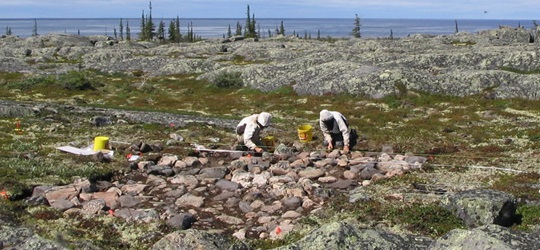
Excavating a pre-Dorset tent near Churchill, Manitoba.
This course provides an introduction to the two of the four fields of anthropology: Biological Anthropology and Archaeology. I teach the archaeology portion, which introduces some of the ethical challenges archaeologists face and looks at how the archaeological record forms and how we find and investigate sites. It also covers the frameworks archaeologists use in making interpretations, how we reconstruct past interactions between people and their environments, and how we study social organization, identity and ideology. Students get hands-on experience with artifacts in the labs.
ANTHRO 2229 Arctic Archaeology
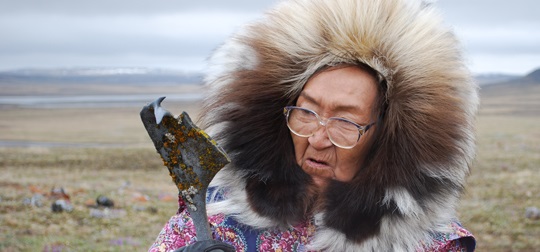
Inuvialuit Elder Jean Harry examines worked caribou antler at Head Hill archaeological site.
This is both an exciting and challenging time to do archaeological research in Canada’s Arctic. New collaborative endeavours between northern Indigenous peoples and archaeologists are changing the way we understand and conduct archaeology in the north. At the same time, climate change, which is dramatically impacting the Arctic, is rapidly destroying the arctic archaeological record and driving new approaches to documenting threatened sites and mitigating these impacts. As a class, we will reflect on how these parallel developments are reshaping archaeological practice in the north and explore some of the major research questions in Arctic archaeology. Ultimately, I hope the course will give you a sense of Canada’s rich arctic past, and insight into how and why archaeological approaches to understanding that past have changed in recent years.
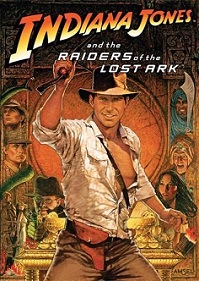 ANTHRO 2261 Adventures in Pop Culture Archaeology
ANTHRO 2261 Adventures in Pop Culture Archaeology
Famous archaeological sites and objects have long captured the public imagination, so it’s no surprise that archaeology abounds in popular culture. It is often represented, both fictionally and factually, in television and movies, on the internet, and in comics, video games and news media. This course examines how both non-archaeologists and archaeologists present archaeology to the public and considers what these representations imply about the relationship between archaeology and modern society. From Indiana Jones to alien pyramid builders, join us for the ride!
ANTHRO 3310 Zooarchaeology 
This course will introduce you to the wide range of information that can be gleaned about past human groups from the animal remains they left behind after butchery, meals, toolmaking and other activities. You will also learn to identify and analyze faunal remains, including the broken fragments often recovered from archaeological sites. Each week, we will cover topics in zooarchaeological theory and practice including taphonomy, quantification, seasonality, prey selection, domestication and behavioural ecology. Come prepared to apply what you have read to the analysis and interpretation of example data! In the labs, you will learn the basics of skeletal identification for the most common types of vertebrate remains recovered from archaeological sites: fish, birds, carnivores, rodents and ungulates. Open lab hours will allow you to practice and reinforce these skills.
ANTHRO 9001 Professional Development
This grad course is open to MA and PhD students in the Anthropology department.
So you want a job when you leave here? Don’t panic! Anthropologists develop a suite of valuable transferrable skills that you can apply in a wide range of job settings. This course aims to help you identify and strengthen your marketable skills and learn to present yourself effectively to prospective employers both within and outside of academia. These skills include time management, oral communication, grant writing, teaching, leadership, research, project management, editing, interpersonal skills, and an appreciation of ethical and civic responsibility. This course emphasizes peer and participatory learning and includes a series of collaborative and individual exercises that will not only serve to enrich your skills, but also provide you with concrete experiences to add to your CV. Past group projects have included designing and implementing a full day anthropology workshop for the Thames Valley District School Board’s (TVDSB) gifted itinerant program and developing grad student resources for the department website.
Graduate Supervision
I welcome applications from students interested in community archaeology and digital heritage, especially those who might want to join the Inuvialuit Living History team. I would also be happy to supervise research projects involving zooarchaeology, gender archaeology, Arctic archaeology and archaeological practice (especially in Canada).
Current Students
M. Beth Compton, PhD candidate: Engaging with Archaeological Collections in Community Archaeology: examining the value of digital representations and physical replicas. Joint supervisor with Neal Ferris.
Rebecca Goodwin, PhD candidate: Engendering the Inuvialuit past.
Ashley Piskor, PhD candidate: Indigenous archaeology, community-based research, cultural heritage management
Kaylee Woldum, MA candidate: Co-Developing a Two-Eyed Seeing Approach to Archaeology Education
Emily Henry, MA candidate: Inuvialuit data sovereignty in the heritage realm.
Isaac Bender, MA candidate: Evaluating methods and techniques for unmarked grave investigations.
Katie Lewis, MA candidate: Isotopic analysis of Thule Inuit canid remains
Former PhD Students
2018 John Moody: Petrographic Analysis of Inuit Ceramics Joint supervisor with Linda Howie.
2017 Jordon Munizzi: Rethinking Holocene Ecological Relationships Among Caribou, Muskoxen, and Human Hunters on Banks Island, NWT, Canada: A Stable Isotope Approach. Joint supervisor with Fred Longstaffe (Earth Sciences).
2016 Laura Kelvin: There is more than One Way to do Something Right: Applying Community-Based Approaches to an Archaeology of Banks Island, N.W.T.
2011 Lindsay Foreman: Seasonal Subsistence in Late Woodland Southwestern Ontario: An Examination of the Relationships between Resource Availability, Maize Agriculture and Faunal Procurement and Processing.
Former MA Students
2022 Jason Lau: Inuvialuit Living Art: Co-Creating Local Community Archaeology and Cultural Heritage Research2019 Jeff Grieve: Digital Representation of Inuvialuit Traditional Knowledge: A case study in community engagement using Google Ear
2018 Shane McCartney: Guided by Smoke: A Comparative Analysis of Early Late Woodland Smoking Pipes from the Arkona Cluster.
2017 Arwen Johns: The Richness of Food: A Zooarchaeological Analysis of Huaca Santa Clara and Huaca Gallinazo, North Coast of Peru. Joint supervisor with Jean-Francois Millaire.
2016 Kathryn Kotar: Variability in Thule Inuit Subsistence Economy: A Faunal Analysis of OkRn-1, Banks Island, N.W.T.
2016 Tessa Plint (MSc, Earth Sciences): Giant beaver (Castoroides) palaeoecology inferred from stable isotopes. Joint supervisor with Fred Longstaffe.
2014 Colleen Haukaas: New Opportunities in Digital Archaeology: The Use of Low-Cost Photogrammetry for 3D Documentation of Archaeological Objects from Banks Island, NWT.
2013 Claire Venet-Rogers: A Study of Faunal Consumption at the Gallinazo Group Site, Northern Coast of Peru. Joint supervisor with Jean-Francois Millaire
2010 John Sweeney: Faunal Analysis of a Ritual Deposit from the Dorchester Iroquoian Village Site (AfHg-24).
2010 John Moody: Pioneering Thule Inuit Subsistence: A Faunal Analysis of Tiktalik (NkRi-3).
2008 Tomasz Porawski: A Multivariate Taphonomic Approach to Understanding Midden Formation in Thule Inuit Contexts: A Case Study from Arctic Canada.
2006 Jacob Anderson: Pre-Dorset life in Southwestern Hudson Bay as seen through Lithic Reduction.
MA Research Opportunity
As part of the SSHRC funded Onkwehón:we Project: Territory, Identity and Social Interactions in Ancestral Iroquoia, we are seeking an MA student to conduct zooarchaeological analysis on the Dorchester Iroquoian village. Excavation of seventeen longhouses at this large 14th century site has produced an extensive faunal collection that invites intra-site comparisons within and between houses. The successful student will have the opportunity to collaborate with other scholars involved in the Onkwehón:we project to situate their findings within the broader regional context. Candidates should have completed an introductory zooarchaeology course or have equivalent practical experience with faunal identification. Interested students should send a CV to Peter Timmins (ptimmins@uwo.ca) and Lisa Hodgetts (lisa.hodgetts@uwo.ca) who can provide further details. We are currently accepting applications for September 2026 admission.
PhD Research Opportunity
Inuit Heritage Trust, Inc. (IHT) in partnership with the Irniurviit Area Co-Management Committee (ACMC) and the University of Western Ontario seek a PhD student to help lead a community-based archaeology mapping project of the Ikkattuaq Migratory Bird Sanctuary (MBS), southwestern Salliq (Southampton Island). The project will be supervised by Dr. Lisa Hodgetts at Western University and the successful applicant will apply for admission to the PhD program in Anthropology at Western. The project will involve documenting archaeological sites of the unique cultural group who developed on the island in relative isolation from neighbouring Inuit and who at the beginning of the 20th century were decimated by European diseases. The project will have a strong focus on building capacity in archaeology among Sallirmiut and its priorities will evolve according to community interests and concerns. IHT will coordinate community engagement activities and collaborate on project management and funding opportunities. Interested candidates should send a CV to Lesley Howse (IHT: lhowse@ihti.ca) and Lisa Hodgetts (Western: lisa.hodgetts@uwo.ca) who will provide more information about the project and how to apply. Now accepting applications for Sept. 2026 although a Jan. 2025 start could be possible.
